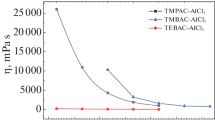Abstract
The conductivity of the mixture of 1-butyl-3-methylimidazolium chloride (BMIC) ionic liquid with aluminum chloride (AlCl3) and titanium chloride (TiCl4) are systematically investigated over a range of temperature (70–110 °C) using the electrochemical impedance spectroscopy (EIS) method. The molar ratios of the components are changed to study the effect of molar ratio on the conductivity. The conductivity data are plotted against temperature to check whether it obeys the Arrhenius law. The activation energy and the density are calculated. The conductivity of the solution increases with increasing temperature for every composition. For varying molar ratio, conductivity increases with increasing TiCl4 content up to a certain composition then starts to decrease for each temperature. At room temperature, density of the solution increases with increasing TiCl4 content in the solution.
Access this chapter
Tax calculation will be finalised at checkout
Purchases are for personal use only
Similar content being viewed by others
References
Galiński M, Lewandowski A, Stępniak I (2006) Ionic liquids as electrolytes. Electrochim Acta 51:5567–5580. https://doi.org/10.1016/j.electacta.2006.03.016
Huddleston JG, Visser AE, Reichert WM et al (2001) Characterization and comparison of hydrophilic and hydrophobic room temperature ionic liquids incorporating the imidazolium cation. Green Chem 3:156–164. https://doi.org/10.1039/b103275p
Sakaebe H, Matsumoto H, Tatsumi K (2007) Application of room temperature ionic liquids to Li batteries. Electrochim Acta 53:1048–1054. https://doi.org/10.1016/j.electacta.2007.02.054
Andriyko YO, Reischl W, Nauer GE (2009) Trialkyl-substituted imidazolium-based ionic liquids for electrochemical applications: basic physicochemical properties. J Chem Eng Data 54:855–860. https://doi.org/10.1021/je800636k
Mahapatro A, Suggu SK (2018) Modeling and simulation of electrodeposition: effect of electrolyte current density and conductivity on electroplating thickness. Adv Mater Sci. https://doi.org/10.15761/ams.1000143
Vila J, Ginés P, Rilo E et al (2006) Great increase of the electrical conductivity of ionic liquids in aqueous solutions. Fluid Phase Equilib 247:32–39. https://doi.org/10.1016/j.fluid.2006.05.028
Zhang Q-G, Sun S-S, Pitula S et al (2011) Electrical conductivity of solutions of ionic liquids with methanol, ethanol, acetonitrile, and propylene carbonate. J Chem Eng Data 56:4659–4664. https://doi.org/10.1021/je200616t
Wileńska D, Anusiewicz I, Freza S et al (2014) Predicting the viscosity and electrical conductivity of ionic liquids on the basis of theoretically calculated ionic volumes. Mol Phys 113:630–639. https://doi.org/10.1080/00268976.2014.964344
Leys J, Wübbenhorst M, Menon CP et al (2008) Temperature dependence of the electrical conductivity of imidazolium ionic liquids. J Chem Phys 128:064509. https://doi.org/10.1063/1.2827462
Shinde PS, Ahmed AN, Nahian MK, Peng Y, Reddy RG (2020) Conductivity of 1-Ethyl-3-Methylimidazolium Chloride (EMIC) and Aluminum Chloride (AlCl3) Ionic Liquids at Different Temperatures and AlCl3 Mole Fractions. ECS Trans 98:129–139. https://doi.org/10.1149/09810.0129ecst
Middlemiss LA, Rennie AJ, Sayers R, West AR (2020) Characterisation of batteries by electrochemical impedance spectroscopy. Energy Rep 6:232–241. https://doi.org/10.1016/j.egyr.2020.03.029
Encinas-Sánchez V, Miguel MD, Lasanta M et al (2019) Electrochemical impedance spectroscopy (EIS): an efficient technique for monitoring corrosion processes in molten salt environments in CSP applications. Sol Energy Mater Sol Cells 191:157–163. https://doi.org/10.1016/j.solmat.2018.11.007
Uddin M-J, Cho S-J (2018) Reassessing the bulk ionic conductivity of solid-state electrolytes. Sustain Energy Fuels 2:1458–1462. https://doi.org/10.1039/c8se00139a
Wei Z, Ren Y, Wang M et al (2020) Improving the conductivity of solid polymer electrolyte by grain reforming. Nanoscale Res Lett 15:122. https://doi.org/10.21203/rs.3.rs-17250/v1
Lu J, Dreisinger D (2003) Electrochemistry: ionic liquid electroprocessing of reactive metals. ACS Symp Ser 495–508. https://doi.org/10.1021/bk-2003-0856.ch039
Shinde PS, Peng Y, Reddy RG (2020) Electrodeposition of titanium aluminide (TiAl) alloy from AlCl3–BMIC ionic liquid at low temperature. In: TMS 2020 149th annual meeting & exhibition supplemental proceedings. The minerals, metals & materials series, pp 1659–1667. https://doi.org/10.1007/978-3-030-36296-6_153
Pradhan D, Reddy R, Lahiri A (2009) Low-temperature production of Ti-Al alloys using ionic liquid electrolytes: effect of process variables on current density, current efficiency, and deposit morphology. Metall Mater Trans B 40:114–122. https://doi.org/10.1007/s11663-008-9214-y
Yuan W-L, Yang X, He L et al (2018) Viscosity, conductivity, and electrochemical property of dicyanamide ionic liquids. Front Chem. https://doi.org/10.3389/fchem.2018.00059
Zheng Y, Dong K, Wang Q et al (2012) Density, viscosity, and conductivity of Lewis acidic 1-butyl- and 1-hydrogen-3-methylimidazolium chloroaluminate ionic liquids. J Chem Eng Data 58:32–42. https://doi.org/10.1021/je3004904
Ferrara C, Dall’Asta V, Berbenni V et al (2017) Physicochemical characterization of AlCl3–1-ethyl-3-methylimidazolium chloride ionic liquid electrolytes for aluminum rechargeable batteries. J Phys Chem C 121:26607–26614. https://doi.org/10.1021/acs.jpcc.7b07562
Rosol ZP, German NJ, Gross SM (2009) Solubility, ionic conductivity and viscosity of lithium salts in room temperature ionic liquids. Green Chem 11:1453. https://doi.org/10.1039/b818176d
Tong J, Wu S, Solms NV et al (2020) The effect of concentration of lithium salt on the structural and transport properties of ionic liquid-based electrolytes. Front Chem. https://doi.org/10.3389/fchem.2019.00945
Vila J, Ginés P, Pico J et al (2006) Temperature dependence of the electrical conductivity in EMIM-based ionic liquids. Fluid Phase Equilib 242:141–146. https://doi.org/10.1016/j.fluid.2006.01.022
Kamavaram V (2004) Novel electrochemical refining of aluminum based materials in low temperature ionic liquid electrolytes. Ph.D. thesis, The University of Alabama
Acknowledgements
The authors acknowledge the financial support from the National Science Foundation (NSF) and ACIPCO for this research project. The authors also thank the Department of Metallurgical and Materials Engineering, The University of Alabama, for providing the experimental and analytical facilities.
Author information
Authors and Affiliations
Corresponding author
Editor information
Editors and Affiliations
Rights and permissions
Copyright information
© 2021 The Minerals, Metals & Materials Society
About this paper
Cite this paper
Nahian, M.K., Ahmed, A.N., Shinde, P.S., Reddy, R.G. (2021). Conductivity of AlCl3-BMIC Ionic Liquid Mixtures Containing TiCl4 at Different Temperatures and Molar Ratios. In: TMS 2021 150th Annual Meeting & Exhibition Supplemental Proceedings. The Minerals, Metals & Materials Series. Springer, Cham. https://doi.org/10.1007/978-3-030-65261-6_90
Download citation
DOI: https://doi.org/10.1007/978-3-030-65261-6_90
Published:
Publisher Name: Springer, Cham
Print ISBN: 978-3-030-65260-9
Online ISBN: 978-3-030-65261-6
eBook Packages: Chemistry and Materials ScienceChemistry and Material Science (R0)




